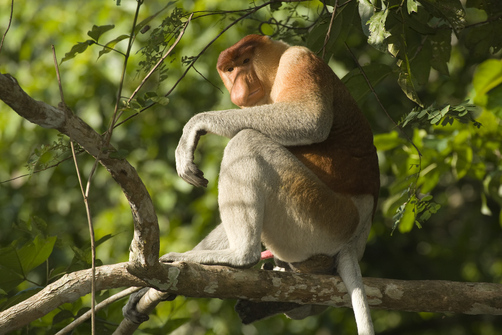Proboscis monkeys: unusual monkeys, unusual facts.
- ‘Proboscis monkeys’ are also known as ‘long-nosed monkeys’, and in the Malay language, ‘bekantan’ and ‘monyet belanda’, the latter literally meaning ‘Dutch monkey’, referring to the perceived appearance of some Dutchmen.
- Proboscis monkeys are endangered primates from the family Cercopithecidae, the family of Old World monkeys and they can only be found in the wild on Asia’s Borneo, an island that has regions that belong to Indonesia, Malaysia and Brunei.
- Proboscis monkeys can grow to be 53 to 76 centimetres (21 to 30 inches) in height and typically weigh 16 to 22.5 kilograms (35 to 50 pounds) in males or 7 to 12 kilograms (15 to 26 pounds) in females, and greater weights for both genders have been recorded.
- Proboscis monkeys have a fur coat that differs in colour, that can include orange shades, red-brown, yellow-brown and shades of grey in colour.
- Male proboscis monkeys have exceptionally large noses, growing up to at least 10 centimetres (3.9 inches) in length, that are believed to be used to project sound, and both genders have protruding bellies.
Male Proboscis Monkey
Image courtesy of National Geographic
- Proboscis monkeys generally live in single-male or male-only bands or harems, of up to 60 and 19 monkeys respectively, and the females give birth to their young most commonly during night or early in the morning.
- Proboscis monkeys are preyed on by leopards, monitor lizards, pythons, eagles and crocodiles.
- Proboscis monkeys usually live a close distance to water, usually in forests near rivers, oceans, and swamps, and they have webbed feet and are accomplished swimmers, reaching depths of 20 metres (65.5 feet), sometimes ‘belly flopping’ into the water from trees.
- Proboscis monkeys commonly use honk noises to vocalize when communicating, although they use roaring or snarling sounds when aggressive.
- Proboscis monkeys’ diet mainly consists of fruit, seeds, and leaves, and the fruit is usually eaten when it is not ripe due to the sugar content in ripe fruit that can cause death due to bloating.
Bibliography:
Proboscis Monkey, 2014, National Geographic, http://animals.nationalgeographic.com.au/animals/mammals/proboscis-monkey/
Proboscis Monkey, 2014, Wikipedia, http://en.wikipedia.org/wiki/Proboscis_monkey







